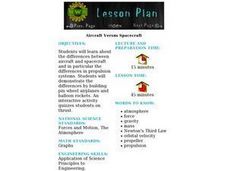Curated OER
Hovercraft Racers!
Students gain first-hand experience on how friction affects motion. They build a hovercraft using air from a balloon to levitate a craft made from a compact disk (CD), learning that a bed of air under an object significantly reduces the...
Curated OER
Aircraft vs. Spacecraft
Students investigate differences between aircraft and spacecraft, and the differences in propulsion systems. They build pinwheel airplanes and balloon rockets. An interactive activity quizzes students on thrust.
Curated OER
Rocket Car
Students construct a balloon-powered rocket car from a Styrofoam tray, pins, tape, and a flexible straw, and test it along a measured track on the floor. They experiment with ways of increasing the distance the rocket car travels.
Curated OER
States of Matter For Grades Kg-8
Students conduct studies of states of matter. In this science lesson plan, students observe the properties of matter and classify different substances as solids, liquids, and gases.
Curated OER
A Hair Raising Experience
Fifth graders conduct an investigation using glass, metal ,fur, latex balloon, plastic bag and hair to generate static electricity of varying amounts. They predict, observe, make comparisons, and draw conclusions about static electricity...
Curated OER
Gases, Pressure, and Volume
Students investigate the relationship between pressure and volume in gases. In this gases, pressure and volume lesson plan, students learn about the meaning of pressure. They observe different nail boards and are able to sit on the...
Curated OER
Understanding Air Pressure
Fifth graders complete experiments with air to understand that air takes up space, has mass, and that air pressure can be changed. In this air pressure lesson, 5th graders test the air pressure by using balloons, syringes, and water to...
Curated OER
Buoyancy-Why Things Float
In this buoyancy worksheet, students read about the principles behind objects floating including density, buoyancy and Archimedes' Principle. Students complete a buoyancy lab where they use a balloon and water and a film canister and...
Curated OER
Magnets
Students demonstrate the process of science by posing questions and investigating phenomena through language, methods and instruments of science as they experiment at four teacher-created stations to explain the fundamentals of magnetism.
Curated OER
The Big "Why"
Students examine the Q.& A. article found each week in the Science Times, focusing on how the answers present scientific data in a clear and logical manner. They write their own questions and answer other classmates' questions in the...
Curated OER
Analysis of Atmospheric Conditions for a High Mountain Retreat
Students examine the relationship between altitude, atmospheric pressure, temperature and humidity at a particular location. They practice science and math in real world applications. They write reports detailing their scientific...
Curated OER
Discovering the Properties of Matter
Students identify the properties of the three states of matter and observe the movement of Oobleck and be able to compare its movement to that of solids and liquids. They record in their Science Journal what they discovered about Oobleck.
Curated OER
Modeling the Big Bang and the Formation of the Universe
Sixth graders conduct an experiment to understand the Big Bang Theory. In this Big Bang Theory lesson, 6th graders will observe a balloon with confetti popping to emulate and analyze information related tot he Big Bang theory....
Curated OER
Earthquakes
Fifth graders explore the causes of earthquakes and the various types of fault lines through a variety of hands-on demonstrations using prepared cakes. They record their observations in their science journals.
Curated OER
Biotechnology: Drug Delivery and Diffusion
Students discover advances in biomedical technology such as transdermal delivery and other non-invasive procedures. In lab activities, they examine how medication is given and how molecules travel, observe electrophoresis, and conduct...
Curated OER
The Sense Of Touch
Students explore the sense of touch. In this science lesson plan, students participate in hands-on activities that broaden their perspectives pertaining the sense of touch.
Curated OER
What A Gas!
Students study various aspects of air. In this science lesson plan, students discover that air occupies space, understand the visual effects of air, and explain how air exerts force.
Curated OER
Weather
Students gain an understanding of air pressure. In this science lesson plan, students define weather, understand pressure, specifically air pressure, demonstrate the pushing power and other properties of air, and learn how a barometer is...
Curated OER
States of Matter
Student explore states of matter. In this science lesson plan, students define matter, identify the states of matter, tell about the properties of each state of matter, and demonstrate an understanding of the difference between a...
Curated OER
Exploring The Oceans
In this science worksheet, students look for the information in order to answer the basic facts concerning common marine life using puzzles.
Curated OER
The Intertidal Zone: Tide and How Creatures Survive
Students explore oceanography by completing science worksheets. In this tide pools lesson, students discuss the forces of the tide pools, the animals that live within them, and the impact they have on the rest of the ocean. Students...
Curated OER
Sounds Like Science - Drums
Students see that understanding how sound is produced makes it possible for us to manipulate it so we can decrease the number of unpleasant sounds we encounter. They make a drum to explore the concepts of force, pitch and volume.
Curated OER
The Electron "Do"
In this electron worksheet, students experiment with a balloon and their lab partner's hair. They determine if hair or the balloon releases electrons and they also determine which type of hair transfers electrons the best.
Curated OER
Blow It Up
Students observe an experiment. In this science instructional activity, students watch an experiment where baking soda and vinegar are used to blow up a balloon. Students answer comprehension questions about the experiment.























